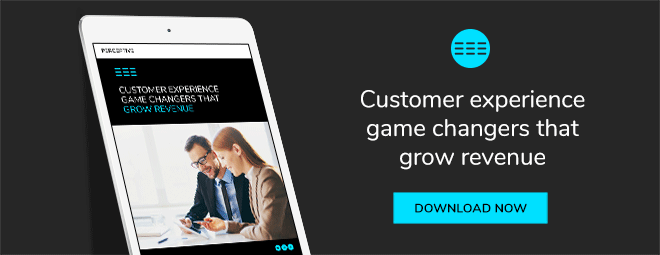
One of the biggest challenges for CEOs today is how to genuinely connect with customers. As Joel Kessel, president of Kessel Communications says in his own words:
CEOs must continue fighting the urge to be lured by the latest and greatest shiny new thing and navigating through a myriad of ways to connect, engage and communicate with our customers. There's so much available at our fingertips that it's easy for small businesses to get lost in a sea of tweets, periscopes, Facebook ads, podcasts, webinars, press releases, and on and on.
So how do forward-thinking CEOs stay focused on the customer and serving their needs? Here are the six strategies that can help you achieve that goal:
1. Have a clear vision and a shared purpose
A successful CX programme relies on the full conviction of your employees and a joint purpose to serve the customer's true needs. As a CEO, sharing your vision and purpose is best done through a clear and simple statement of intent. Just like your brand vision, or any one of your key business objectives, having a vision for where you would like your CX to be, is just as important and will do just as much for your bottom line.
This vision needs to be authentic and completely in line with your company's brand value proposition, which needs to be made clear to every employee.
Having a statement of intent can allow you to activate your employees to deliver CX value on a consistent basis. This is then completely in line with your business purpose and at the same time, aligns everyone to a common goal.
If you already have a vision, or think you do, question if you really understand your company's vision for the CX it wants to deliver. Do your colleagues know what that vision is? According to Forrester, few CX professionals regularly share their CX vision and strategy with all employees, and even fewer do so in a consistent way. Yet, as Forrester points out “great customer experiences are built on solid strategies executed by people sharing a common vision.”
Related content: Fuelling the CX Flywheel: the secret to sustainable growth
2. Let the customer lead the redesign of your business
To be a leader in the CX space, your CX purpose must completely differentiate you from your competitors. Conduct research to identify what your most important customer journey is (through voice-of-customer feedback) and use the insights this generates to improve the steps that make up that journey.
Keep the customer and their mindset in mind while you (re)design the supporting processes for your CX. This will help remove crucial pain points in customer interactions. Shifting to a customer-centric design will kick-start the ethos throughout the company of constantly improving and innovating the customer experience, which will help transform your business on a more fundamental level.
3. Use behavioural psychology to design your customer interactions
This can create additional value and allow you to skillfully shape customer perceptions. As previously mentioned, designing a CX journey requires thorough research, and you can use the findings you uncover to improve the interactions that have the biggest impact on customer perceptions and satisfaction levels.
For example, you can design the sequence of interactions to always end on a positive note. Another example is to merge a number of interactions to make them feel less lengthy and to prompt a feeling of progress. Giving customers the feeling of having control and choice can be derived from providing simple self-service options.
4. Leverage digital to redesign customer journeys
As some of the big players (such as Apple, Amazon, and Google) in the market provide such superior CX, that is what customers start to expect from all businesses.
By making the processes behind the most important customer journeys digital, you can ensure a smooth and consistent CX. Further, embracing digital ways of working allows companies to become more agile and respond quickly to change, which could help you outperform your competitors.
Aligning teams from multiple disciplines in an online space helps you become more agile and to cooperatively design, test and iterate processes that have a high impact on CX. These processes should, after gathering and acting on customer feedback, be continually refined and iterated.
5. Align the business to deliver against clear outcomes
Once your company is committed to being customer-focused, it's vital that you structure your business to fully embrace these changes across each department. In many cases, just getting started is a big challenge. To ensure you stay on track, consistently measure your customer feedback and implement a customer-led governance structure so that you can deliver on the objectives you’ve set out.
A major game changer is also empowering your employees (especially those on the customer service front lines) to deliver against your CX vision. Getting some wins in early, ideally financial ones, means this is more likely to gain momentum and deliver value to your business.
In order to fully embrace your new vision and organisational structure, invest in your employees. Find ways to motivate and empower them and in turn they’ll embody the CX and brand promise at every touchpoint.
As a customer-centric CEO, get out into the field with your front-line employees often, taking calls and working directly with them can go a long way to encouraging them.
6. Set metrics to measure customer feedback
It’s good practice to measure your feedback, however, to truly satisfy your customers, go a step beyond. Use these valuable insights to uncover actionable changes you can make and apply them throughout your company. This will drive change across the business.
This is best executed through an advanced CX management system, with sophisticated features that alert you to any grievances straight away. Look for a platform that will put your customer journey(s) at the forefront (according to your priorities) and connect these to your business goals and any operational improvements.
One you have implemented a voice-of-customer programme, you can use it to detect cross-functional issues and address their root causes.
Read more: Top tips for CX culture game changers
Although many executives understand the importance of improving CX and including it as a part of the business strategy, the challenge is often changing and restructuring the organisation—and deciding where and how to start. Often, a full customer-centric transformation requires a cultural, operational and financial change.
Learn more about customer experience strategies for businesses wanting to be customer-led and grow their revenue, get our CEO Guide here:
1. BusinessDaily.com
2. Mobilize Your Customer Experience Strategy, Forrester, February 2015
3. ibid.
4. Customer Experience, Creating value through transforming customer journeys, McKinsey& Company, 2016
